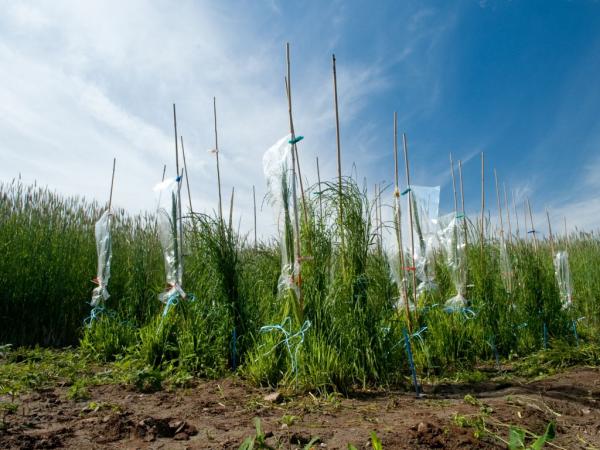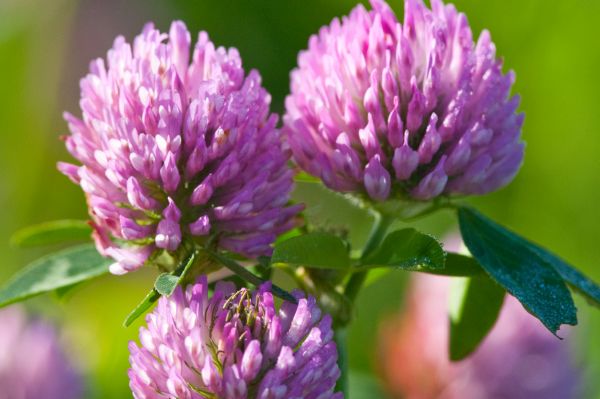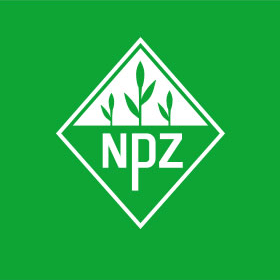Fodder Plants
There is a long tradition of breeding fodder plants at NPZ. Breeding work on forage grass such as perennial ryegrass and the small-grained legume red clover started 120 years ago.
Since 1 August 2015, at the site in Malchow and others, NPZ works on the breeding programme for fodder plants DNF together with DSV as our cooperation partner. On the part of NPZ, topical focuses of this fodder plant cooperation relate to breeding perennial ryegrass (tetraploid) and red clover.
Work on Italian ryegrass also has a long history, however, further breeding within the DNF-cooperation is currently being undertaken at DSV. The Italian ryegrass LEMA has been registered with the Federal Plant Variety Office since 1955, thus being our oldest variety at NPZ.
With the onset of the breeding cooperation DNF, the crops white clover, timothy and meadow fescue have also been integrated into the breeding work of NPZ.

Perennial Ryegrass
As with the breeding of red clover, breeding of perennial ryegrass is also a sector with a long tradition. Breeding focuses on the selection of high-performance, persistent varieties in medium to late maturity groups. With regard to resistance breeding, the selection of genotypes with snow mould- and rust-tolerance takes centre stage.
The performance of our newly bred varieties is particularly determined by dry matter yield. Performance test plots are seeded in three to four repetitions and are cut, with practical orientation, four to six times a year with a green fodder harvester. Further to the fresh weight harvested, dry matter yield is also recorded. Since perennial ryegrass is used in permanent pasture for many years, our performance test plots are also mowed for at least three years. At the end of the growing period, the data from all cuttings are processed and evaluated. Only test candidates showing high dry matter yields across all cuttings and years, and further positive characteristics such as resistances, will continue to be assessed and potentially be enrolled for registration at the Federal Plant Variety Office or one of the European Plant Variety Offices.
Breeding of red clover – long-lasting and successful tradition
From 1900, Hans Lembke had already begun to take harvested seeds from outstanding individual fodder crop plants and use these seeds in mixtures for new seeding on his parents’ farm. In 1908, he established observation plots with single-plant progeny for the first time, in order to compare them with different varieties and origins. The extremely hard winter of 1911/12 with very little snow laid the basis for Lembke’s successful breeding endeavours. In the spring of 1912, he dug out 50 vital plants from a field that was almost entirely destroyed by winterkilling, and planted them in his nursery for further observation and seed collection. The seeds from the best plants were then used in the next year for establishing a single growing plot and further mother pedigree breeding with individual selection and progeny evaluation.
In 1915, and on a slightly different genetic basis, ‘Original Lembke’s red clover’ was registered and entered in the DLG-Register of Selective Breeding Achievements.
After the Second World War, ‘Lembke’s red Clover’, known as variety MARINO in the German Democratic Republic from 1961, reached a very high market significance due to the successful maintenance breeding, and became a much asked for export hit. Up to 2000, the variety was in the list of varieties, but then had to be taken off after almost 40 years of successful cultivation and sales because seed dealers used the commonly known and positive name of this variety for illegal seed businesses. In Western Germany, ‘Lembke’s red clover’ continued to live in the variety LERO and remained in the list of varieties until 1982. Further diploid varieties such as PIRAT, DIPLOMAT, HARMONIE, KONTIKI, REGENT, LORELEY and SAPHIR were also entered in the list of varieties.

New impulses by tetraploid varieties
With the onset of breeding tetraploid varieties, breeding of red clover received new impulses in 1969. Due to the double set of chromosomes, tetraploid forms feature significantly higher yield performance and also improvements in other important agronomic characteristics such as higher resistance against diseases, better winter hardiness, higher drought tolerance, better competitive power in clover grass mixes and better quality characteristics such as digestibility as well as protein and energy contents.
In 1977, MATRI was registered as the first tetraploid variety, and excelled in terms of high dry matter yield and also good reproducibility.
In addition to yield and seed performance, persistence and resistance against diseases are also important characteristics for red clover. For this reason, an infection field was established in Malchow in order to select strains, after perennial overwintering, with higher resistance against clover rot and root diseases. With the tetraploid variety MANETA registered in 1985, clear breeding progress was achieved in terms of disease resistance and persistence. Breeding has since continued, thus leading to the registration of the varieties MATERO, MARO, MARKUS, MARS, ATLANTIS and MAGELLAN.

